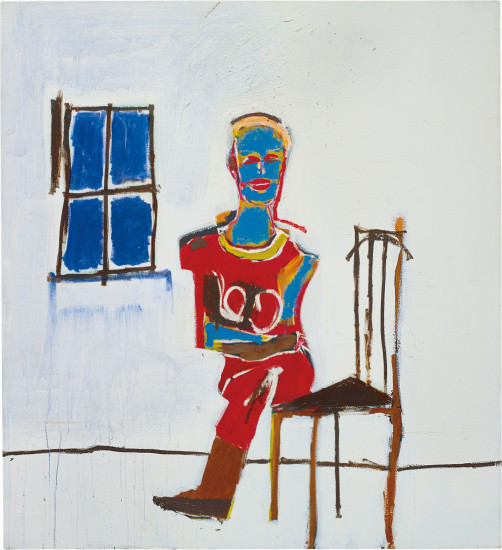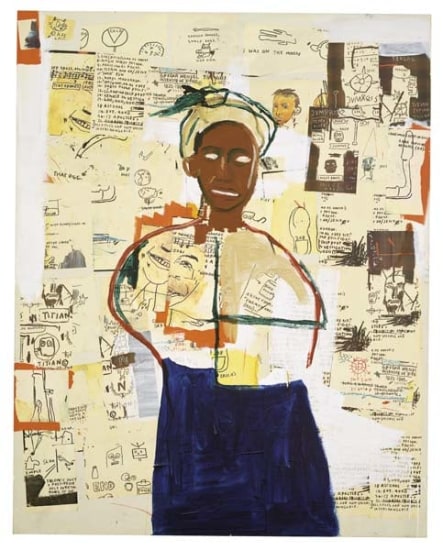Jean-Michel-Basquiat Big Joy 1984 acrylic, oilstick and Xerox collage on canvas 218.5 x 172.5 cm (86 x 67 7/8 in) Signed, titled and dated ‘”BIG.JOY” Jean-Michel-Basquiat SEPT: 1984‘ on the reverse.
Provenance Mary Boone Gallery, New York Private Collection, Europe Exhibited New York, Mary Boone Michael Werner Gallery, Jean-Michel-Basquiat, 2 March–23 March 1985 Paris, Musée d’Art Moderne de la Ville de Paris, Passions privées: Collections particulières d’art moderne et contemporain en France, 18 December 1995–24 March 1996 Milan, Fondazione La Triennale di Milano, The Jean Michel Basquiat Show, September 2006–January 2007 Literature Passions privées: Collections particulières d’art moderne et contemporain en France, exh.cat., Paris, Musée d’Art Moderne de la Ville de Paris, December 1995–March 1996 T. Shafrazi, J. Deitch and R. D. Marshall, Jean-Michel-Basquiat, New York, 1999, p.228 (illustrated) R. D. Marshal, and J. L. Prat, Jean-Michel-Basquiat, Galerie Enrico Navarra, Paris, 2000, 3rded., pp.274–75 (illustrated) The Jean Michel Basquiat Show, exh. cat., Milan, Fondazione La Triennale di Milano, September 2006–January 2007 Catalogue Essay “I just felt really right. I felt like I was glad that I stuck it out and I was glad that I’d had these hard times.” JEAN-MICHEL-BASQUIAT, 1985 Big Joy, executed in 1984, shows Jean-Michel-Basquiat at the height of his powers and the pinnacle of his artistic career. Basquiat’s short-lived career was notoriously troubled and tormented. The artist had ascended spectacularly through the ranks of New York’s high-society art world in the early 1980s, only to succumb to exploitative social and professional pressures, leading to his untimely death at the age of 27. Big Joy expounds upon the most important themes in the artist’s oeuvre, issues which underline his artistic raison d’être: race and identity. Basquiat was the first black artist to break into the white dominated art world and his work reflects the struggles and hardships of a deprived African-American in the face of this ostensible dominance. As a result, Basquiat continually questioned his identity and place in the world, living a life of contradictions and contrasts. Big Joy, as with much of Basquiat’s work, concentrates on the human figure. The focal point is the immense and overwhelming central figure of a black lady – Joy. Standing at roughly seven feet tall, the female figure dwarfs the viewer. The dark tones of the face, hair, arms and legs jump out against the vibrant aurulent backdrop. The figure is thick set, strong and relaxed; she dominates the composition and exudes confidence. Big Joy is a panorama of the artist’s stream of consciousness, depicting an associative attempt on African-American culture. Not only is Basquiat constructing a social commentary on racial inequality and integration, but he also becomes more personal – he’s painting a complex and existential portrait. “Basquiat’s work documents the progressive construction of the artist’s discordant identity, of a man grappling with the reality that he could make little use of the patterns available to him – either of his father’s existence as an accountant who adopted the ideals of the white middle class , or the ghetto kid attitude of the graffiti sprayer. Basquiat’s numerous selfportraits may well be ideal blueprints of the artist as an enraged hero; but they are also terrifyingly bleak documents of inner turmoil and great loneliness.” (L. Emmerling, Basquiat, Cologne, 2006, p. 88) This figure derives aesthetically and subjectively from Basquiat’s earlier paintings. The face itself is characteristically crude with a primitive mask-like rendering with jewel eyes that bore into the viewer. This is reminiscent of the African mask influence in Picasso’s Les Demoiselles d’Avignon of 1907 where he departs from traditional European painting. Further, the gritted grid-like mouth offers a disturbing glimpse into the anxious mind of the young artist. It’s the female subject, with her life-like body shape, proportionate limbs and human demeanour that makes Big Joy so singular. Basquiat’s early portraits pay homage to his black American heroes, predominantly male athl
Jean-Michel-Basquiat Big Joy 1984 acrylic, oilstick and Xerox collage on canvas 218.5 x 172.5 cm (86 x 67 7/8 in) Signed, titled and dated ‘”BIG.JOY” Jean-Michel-Basquiat SEPT: 1984‘ on the reverse.
Provenance Mary Boone Gallery, New York Private Collection, Europe Exhibited New York, Mary Boone Michael Werner Gallery, Jean-Michel-Basquiat, 2 March–23 March 1985 Paris, Musée d’Art Moderne de la Ville de Paris, Passions privées: Collections particulières d’art moderne et contemporain en France, 18 December 1995–24 March 1996 Milan, Fondazione La Triennale di Milano, The Jean Michel Basquiat Show, September 2006–January 2007 Literature Passions privées: Collections particulières d’art moderne et contemporain en France, exh.cat., Paris, Musée d’Art Moderne de la Ville de Paris, December 1995–March 1996 T. Shafrazi, J. Deitch and R. D. Marshall, Jean-Michel-Basquiat, New York, 1999, p.228 (illustrated) R. D. Marshal, and J. L. Prat, Jean-Michel-Basquiat, Galerie Enrico Navarra, Paris, 2000, 3rded., pp.274–75 (illustrated) The Jean Michel Basquiat Show, exh. cat., Milan, Fondazione La Triennale di Milano, September 2006–January 2007 Catalogue Essay “I just felt really right. I felt like I was glad that I stuck it out and I was glad that I’d had these hard times.” JEAN-MICHEL-BASQUIAT, 1985 Big Joy, executed in 1984, shows Jean-Michel-Basquiat at the height of his powers and the pinnacle of his artistic career. Basquiat’s short-lived career was notoriously troubled and tormented. The artist had ascended spectacularly through the ranks of New York’s high-society art world in the early 1980s, only to succumb to exploitative social and professional pressures, leading to his untimely death at the age of 27. Big Joy expounds upon the most important themes in the artist’s oeuvre, issues which underline his artistic raison d’être: race and identity. Basquiat was the first black artist to break into the white dominated art world and his work reflects the struggles and hardships of a deprived African-American in the face of this ostensible dominance. As a result, Basquiat continually questioned his identity and place in the world, living a life of contradictions and contrasts. Big Joy, as with much of Basquiat’s work, concentrates on the human figure. The focal point is the immense and overwhelming central figure of a black lady – Joy. Standing at roughly seven feet tall, the female figure dwarfs the viewer. The dark tones of the face, hair, arms and legs jump out against the vibrant aurulent backdrop. The figure is thick set, strong and relaxed; she dominates the composition and exudes confidence. Big Joy is a panorama of the artist’s stream of consciousness, depicting an associative attempt on African-American culture. Not only is Basquiat constructing a social commentary on racial inequality and integration, but he also becomes more personal – he’s painting a complex and existential portrait. “Basquiat’s work documents the progressive construction of the artist’s discordant identity, of a man grappling with the reality that he could make little use of the patterns available to him – either of his father’s existence as an accountant who adopted the ideals of the white middle class , or the ghetto kid attitude of the graffiti sprayer. Basquiat’s numerous selfportraits may well be ideal blueprints of the artist as an enraged hero; but they are also terrifyingly bleak documents of inner turmoil and great loneliness.” (L. Emmerling, Basquiat, Cologne, 2006, p. 88) This figure derives aesthetically and subjectively from Basquiat’s earlier paintings. The face itself is characteristically crude with a primitive mask-like rendering with jewel eyes that bore into the viewer. This is reminiscent of the African mask influence in Picasso’s Les Demoiselles d’Avignon of 1907 where he departs from traditional European painting. Further, the gritted grid-like mouth offers a disturbing glimpse into the anxious mind of the young artist. It’s the female subject, with her life-like body shape, proportionate limbs and human demeanour that makes Big Joy so singular. Basquiat’s early portraits pay homage to his black American heroes, predominantly male athl

.jpg)









Try LotSearch and its premium features for 7 days - without any costs!
Be notified automatically about new items in upcoming auctions.
Create an alert